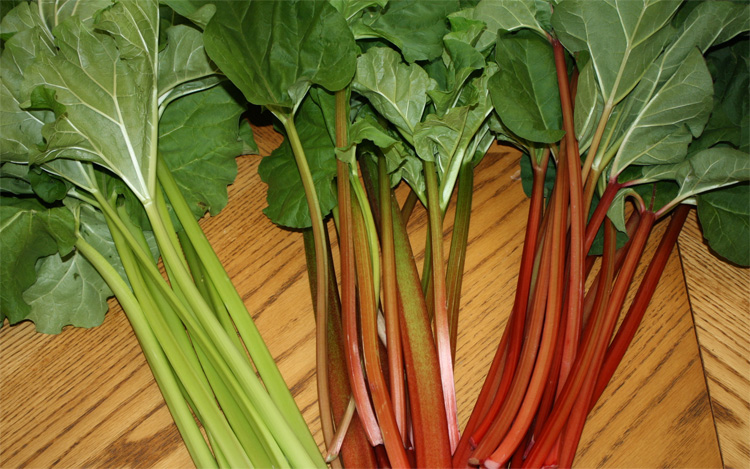Rhubarb general information
Rhubarb (Rheum rhabarbarum) is a species of plant in the family Polygonaceae. They are herbaceous perennials growing from short, thick rhizomes. They have large leaves that are somewhat triangular, with long fleshy petioles. They have small flowers grouped in large compound leafy greenish-white to rose-red inflorescences.
In culinary use, fresh raw petioles (leaf stalks) are crisp (similar to celery) with a strong, tart taste. Most commonly, the plant’s leaf stalks are cooked with sugar and used in pies and other desserts. A number of varieties have been domesticated for human consumption, most of which are recognised as Rheum x hybridum by the Royal Horticultural Society.
Rhubarb is usually considered a vegetable. In the United States, however, a New York court decided in 1947 that since it was used in the United States as a fruit, it counted as a fruit for the purposes of regulations and duties. A side effect was a reduction on imported rhubarb tariffs, as tariffs were higher for vegetables than fruits.
Rhubarb contains anthraquinones including rhein, and emodin and their glycosides (e.g. glucorhein), which impart cathartic and laxative properties. It is hence useful as a cathartic in case of constipation.
.
 . .
Rhubarb is grown in many areas. With greenhouse production, it is available throughout much of the year. Rhubarb grown in hothouses (heated greenhouses) is called hothouse rhubarb, and is typically made available at consumer markets in early spring, before outdoor cultivated rhubarb is available. Hothouse rhubarb is usually brighter red, more tender and sweeter-tasting than outdoor rhubarb. In temperate climates, rhubarb is one of the first food plants harvested, usually in mid- to late spring and the season for field-grown plants lasts until September. Rhubarb is ready to consume as soon as harvested, and freshly cut stalks are firm and glossy.
In the United Kingdom, the first rhubarb of the year is harvested by candlelight in forcing sheds – where all other light is excluded – a practice that produces a sweeter, more tender stalk. These sheds are dotted around the noted “Rhubarb Triangle” of Wakefield, Leeds, and Morley.
Rhubarb grows year-round in warm climates, but in temperate climates the above ground portion of the plant completely withers away at the onset of freezing temperature. The plant grows from the root at the return of warm weather. Rhubarb growth can be ‘forced’ or encouraged to grow early by raising the local temperature, usually by placing an upturned bucket over the new shoots.
Rhubarb thrives in areas of direct sunlight and can successfully be planted in containers if they are large enough to accommodate a season’s growth.
Rhubarb damaged by severe cold should not be eaten, as it may be high in oxalic acid, which migrates from the leaves and can cause illness.
The colour of rhubarb stalks can vary from the commonly associated crimson red, through speckled light pink, to simply light green. Rhubarb stalks are poetically described as “crimson stalks”. The colour results from the presence of anthocyanins, and varies according to both rhubarb variety and production technique. The colour is not related to its suitability for cooking.
.
 . .
Cultivation notes
Any fertile garden soil can be used for rhubarb as long as it is well drained and in full sun. Crowns (‘sets’) can be cropped for ten or more years, though division may be necessary after about five years.
Preparing the soil
Although the large foliage can help smother weeds, the ground should be free from perennial weeds before planting. Dig in one to two bucketfuls of well-rotted organic matter such as manure, before planting.
Planting
Plant crowns in November or December. If necessary, planting can continue up to the beginning of March. Buy named cultivars or choose a division from a strong, healthy-looking plant.
Plant the crown with the growing point at, or just below, the soil surface. On wetter soils planting with the buds just raised out of the soil may help prevent rotting. If planting more than one crown, space plants 1m (3ft) apart, with 1-2m (3-6ft) between rows.
Cultivation
In hot summers, if the ground becomes dry, growth will slow down and even stop. A spring mulch of well rotted organic matter 7cm (2 1/2in) deep will help to retain moisture but do not bury the crowns. Plants will also respond to watering during prolonged dry periods in summer. Apply a general fertiliser such as growmore in spring or summer at 70g per sq m (2oz per square yard).
Allow the foliage to die back naturally in autumn then cut away the old leaves to expose the growing points to winter cold. There is no harm in adding these leaves to the compost heap as the poisonous oxalic acid contained in them breaks down during decomposition.
Harvesting
Stems can be picked from the early cultivars from March to April. Do not harvest in the first season after planting and harvest only lightly in the second season to avoid weakening the crowns. From seedling plants, harvest in the second season after planting or in the first season after division.
Stems should be pulled rather than cut to prevent rotting of the remaining stump. Pull stems when they are between 23-30cm (9-12in) long, holding them at the base and pulling gently outwards. Take no more than half the total stems at any one time.
The last harvest is usually in late summer, around July or August, though growth may have stopped before this if the weather is very hot. Concern is sometimes expressed over the concentrations of oxalic acid building up as the season progresses. However, this build-up is mostly in the leaves which are not eaten and the amount in the stems is not sufficient to have a toxic effect.
Forcing
For an early harvest of tender and pink rhubarb cover the crowns in December or January with a layer of straw or bracken and cover over with an upturned bucket or a traditional clay rhubarb pot to exclude light. Stems will be ready to pull two to three weeks earlier than uncovered crowns.
For an even earlier harvest, lift some roots in November. Ideally leave the lifted roots outside for up to two weeks prior to potting to expose them to more cold – this is needed to overcome dormancy. Then pot up with compost and bring into a cool room or greenhouse at a temperature of between 7-16ºC (45-60ºF). Exclude light with buckets or black polythene over crates. Keep the roots damp but not wet. Stems can usually be harvested in five weeks. Crowns forced in this manner are usually much weakened and therefore discarded after harvest.
Propagation
Seed
Sow seed in spring (March/April) 2.5cm (1in) deep in a seedbed or individually in modules. If in a seedbed thin seedlings to 15cm (6in) apart, choosing the most vigorous seedlings. The resulting plants will be more variable than named clones. Plant out in autumn or the following spring.
Division
Division will guarantee a plant identical to the parent and is the most common method of propagation. It is also good practice to divide established crowns about once every five years if they have become weak or overcrowded. Lift crowns between autumn and early spring (usually in November).
Use a spade to divide the crown into sections each retaining a portion of the rhizome (thickened root) and at least one growing point. Sections from the outer part are better than the centres of old plants. Discard any old or decayed parts of the crown. Replant straight away or wrap in damp sacking until ready to plant.
.
Cultivar Selection
‘Early Champagne’ – even cardinal red colour throughout length of stem. Green flesh, pink at edges. Good, strong, reliable cultivar.
‘Early Cherry’ – bright reddish-pink base with red flecking on green towards top. Flesh green. Thick stems.
‘Hawke’s Champagne’ – even currant red colour throughout length of stem. Flesh pale green through to pink. Leaves heart-shaped and attractive. Vigorous. Reliable early variety.
‘Timperley Early’ – base deep red, passing to light green with red flecking. Does not hold colour well. Green flesh with reddish tinges. Heavy cropper. Good for forcing. Disappointing in Harlow Carr taste tests. Frost susceptible.
‘Victoria’ – Late, cardinal red stems with flecking at top. Red flesh tinged green. Very thick stems. Popular old variety.

.
Did you know?
Rhubarb is an ancient vegetable native to Asia and known to the Chinese over 4,000 years ago.
The culinary use of rhubarb in the UK is quite recent, beginning sometime in the late 18thcentury.
Such was its popularity during World War II that a state of Rhubarb Mania was declared – sticks of rhubarb and a bag of sugar were given to children instead of their sweet ration.
For Recipes visit
|








